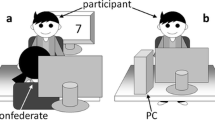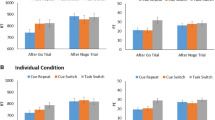Abstract
When sharing a task with another person that requires turn taking, as in doubles games of table tennis, performance on the shared task is similar to performing the whole task alone. This has been taken to indicate that humans co-represent their partner’s task share, as if it were their own. Task co-representation allows prediction of the other’s responses when it is the other’s turn, and leads to response conflict in joint interference tasks. However, data from our lab cast doubt on the view that task co-representation and resulting response conflict are the only or even primary source of effects observed in task sharing. Recent findings furthermore suggest another potential source of interference in joint task performance that has been neglected so far: Self-other discrimination and conflict related to agent identification (i.e., determining whether it is “my” or the other’s turn). Based on these findings we propose that participants might not always co-represent what their partner is supposed to do, but instead co-represent that another agent is responsible for part of the task, and when it is his turn. We call this account the actor co-representation account.




Similar content being viewed by others
Notes
Here and in the following we use the term single response go/nogo task to refer to tasks in which participants have only one response “alternative”, and are either required to respond (go) or to withhold the response (nogo), depending on the task rules, and hence the stimulus presented on a given trial. In contrast, we use the term binary choice task when participants respond on each trial by choosing the appropriate response from two response alternatives. Finally, the term binary choice go/nogo task refers to tasks in which participants respond to some stimuli by choosing between two response alternatives assigned to certain stimuli (go), but have to refrain from responding to other stimuli (nogo).
We thank Andrea Philipp for providing the data of this experiment.
We also analyzed the CNV because previous findings suggests that the late part of the CNV also reflect anticipatory motor preparation when preparing to act oneself as well as when expecting another person’s action (e.g., Kilner et al. 2004; Kourtis et al. 2010). However, in our Exp. 3 there was no significant difference between the CNV found in NoGo trials in the joint and individual task settings. Therefore our results cannot distinguish between the CNV portion that is related to the predictable imperative stimulus and the portion related to action prediction.
Note that neutral flankers in the Atmaca et al. (2011) study cannot distinguish between the two accounts either. This is because neutral flankers (that were not assigned to either agent/response) never occurred in the target position, and hence were not associated with “not my turn” or “withhold response”. Such a condition would be interesting because the actor co-representation account predicts that flanker stimuli assigned to the other agent should lead to more conflict/interference than neutral flankers (also assigned to nogo/withhold responses) in the joint, but not the individual condition. In contrast, the task co-representation account would not predict differences between joint and individual settings for neutral flanker trials because neutral letters are not assigned to the other’s response.
References
Aiello, J.R., and E.A. Douthitt. 2001. Social facilitation from Triplett to electronic performance monitoring. Group Dynamics: Theory, Research, & Practice 5: 163–180.
Amodio, D.M., and C.D. Frith. 2006. Meeting of minds: The medial frontal cortex and social cognition. Nature Reviews Neuroscience 7: 268–277.
Ansorge, U., and P. Wühr. 2004. A response-discrimination account of the Simon effect. Journal of Experimental Psychology: Human Perception and Performance 30: 365–377.
Atmaca, S., N. Sebanz, W. Prinz, and G. Knoblich. 2008. Action co-representation: The joint SNARC effect. Social Neuroscience 3(3–4): 410–20.
Atmaca, S., N. Sebanz, and G. Knoblich. (2011). The Joint Flanker Effect: Sharing tasks with Real and Imagined Co-Actors. Experimental Brain Research.
Coles, M.G.H., G. Gratton, T.R. Bashore, C.W. Eriksen, and E. Donchin. 1985. A psychophysiological investigation of the continuous flow model of human information processing. Journal of Experimental Psychology: Human Perception and Performance 11: 529–553.
Davis, M.H. 1980. A multidimensional approach to individual differences in empathy. JSAS Catalog of Selected Documents in Psychology 10: 85.
Davis, M.H. 1983. Measuring individual differences in empathy: Evidence for a multidimensional approach. Journal of Personality and Social Psychology 44: 113–126.
De Jong, R., C.-C. Liang, and E. Lauber. 1994. Conditional and unconditional automaticity: A dual-process model of effects of spatial stimulus-response correspondence. Journal of Experimental Psychology: Human Perception and Performance 20: 731–750.
Enz, S. 2009. Empathie als mehrdimensionales Konstrukt im Kontext von sozialen Konflikten in Teamsituationen [Empathy as a multi-dimensional construct in the context of social conflicts and of team situations]. Hamburg: Verlag Dr. Kovac.
Eriksen, B.A., and C.W. Eriksen. 1974. Effects of noise letters upon the identification of a target letter in a nonsearch task. Perception & Psychophysics 16: 143–149.
Grice, R.G., and J.W. Gwynne. 1985. Temporal characteristics of noise conditions producing facilitation and interference. Perception and Psychophysics 37: 495–501.
Guagnano, D., E. Rusconi, and C. Umiltà. 2010. Sharing a task or sharing space? On the effect of a confederate in action coding. Cognition 114: 348–355.
Guerin, B. 1993. Social facilitation. Cambridge: Cambridge University Press.
Holländer, A., Jung, C., & Prinz, W. (2011). Covert motor activity on NoGo trials in a task sharing paradigm: evidence from the lateralized readiness potential. Experimental Brain Research. doi:10.1007/s00221-011-2688-x
Hommel, B. 2000. The prepared reflex: Automaticity and control in stimulus-response translation. In Attention and performance XVIII: Control of cognitive processes, ed. S. Monsell and J. Driver, 247–273. Cambridge: MIT Press.
Hommel, B., J. Müsseler, G. Aschersleben, and W. Prinz. 2001. The theory of event coding (TEC): A framework for perception and action planning. Behavioral and Brain Sciences 24: 849–878.
Hommel, B., L.S. Colzato, and W.P.M. van den Wildenberg. 2009. How social are task representations? Psychological Science 20: 794–798.
Kilner, J.M., C. Vargas, S. Duval, S.-J. Blakemore, and A. Sirigu. 2004. Motor activation prior to observation of a predicted movement. Nature Neuroscience 7: 1299–1301.
Koch, I., and A.M. Philipp. 2005. Effects of response selection on the task-repetition benefit in task switching. Memory & Cognition 33: 624–634.
Kornblum, S., T. Hasbroucq, and A. Osman. 1990. Dimensional overlap: Cognitive basis for stimulus-response compatibility—a model and taxonomy. Psychological Review 97: 253–270.
Kourtis, D., N. Sebanz, and G. Knoblich. 2010. Favouritism in the motor system: social interaction modulates action simulation. Biology Letters 6: 758–761.
Lam, M.Y., and R. Chua. 2009. Influence of stimulus-response assignment on the joint-action correspondence effect. Psychological Research 74: 476–480.
Leuthold, H., W. Sommer, and R. Ulrich. 2004. Preparing for action: Inferences from CNV and LRP. Journal of Psychopysiology 18: 77–88.
Liepelt, R., D. Wenke, R. Fischer, & W. Prinz. 2010. Trial-to-trial sequential dependencies in a social and non-social Simon task. Psychological Research, epub ahead of print, doi:10.1007/s00426-010-0314-3
Lu, C.H., and R.W. Proctor. 1995. The influence of irrelevant location information on performance: A review of the Simon and spatial Stroop effects. Psychonomic Bulletin & Review 2: 174–207.
Neill, W.T., L.A. Valdes, K.M. Terry, and D.S. Gorfein. 1992. Persistence of negative priming. II. Evidence for episodic trace retrieval. Journal of Experimental Psychology: Learning, Memory, and Cognition 18: 993–1000.
Philipp, A.M., and W. Prinz. 2010. Evidence for a role of the responding agent in the joint compatibility effect. Quarterly Journal of Experimental Psychology 63: 2159–2171.
Prinz, W. 1997. Perception and action planning. European Journal of Cognitive Psychology 9: 129–154.
Ramnani, N., and R.C. Miall. 2004. A system in the human brain for predicting the actions of others. Nature Neuroscience 7: 85–90.
Rogers, R.D., and S. Monsell. 1995. Costs of a predictable switch between simple cognitive tasks. Journal of Experimental Psychology: General 124: 207–231.
Ruys, K.I., and H. Aarts. 2010. When competition merges people’s behavior: Interdependency activates shared action representations. Journal of Experimental Social Psychology 46: 1130–1133.
Sanders, A.F., and J.M. Lamers. 2002. The Erisksen flanker effect revisited. Acta Psychologica 109: 41–56.
Schuch, S., and I. Koch. 2003. The role of response selection for inhibition of task sets in task shifting. Journal of Experimental Psychology: Human Perception and Performance 29: 92–105.
Sebanz, N., and G. Knoblich. 2009. Prediction in joint action: what, when, and where. Topics in Cognitive Science 1: 353–367.
Sebanz, N., G. Knoblich, and W. Prinz. 2003. Representing others’ actions: just like one’s own? Cognition 88: B11–B21.
Sebanz, N., G. Knoblich, and W. Prinz. 2005. How two share a task: Corepresenting stimulus-response mappings. Journal of Experimental Psychology: Human Perception and Performance 31: 1234–1246.
Sebanz, N., H. Bekkering, and G. Knoblich. 2006. Joint action: Bodies and minds moving together. Trends in Cognitive Sciences 10: 70–76.
Sebanz, N., D. Rebbechi, G. Knoblich, W. Prinz, and C. Frith. 2007. Is it really my turn? An event-related fMRI study of task sharing. Social Neuroscience 2: 81–95.
Simon, J.R. 1990. The effects of an irrelevant directional cue on human information processing. In Stimulus-response compatibility: An integrated perspective, ed. R.W. Proctor and T.G. Reeve. Amsterdam: North-Holland.
Simon, J.R., and A.P. Rudell. 1967. Auditory S-R compatibility: The effect of an irrelevant cue on information processing. Journal of Applied Psychology 51: 300–304.
Simon, J.R., J.V. Hinrichs, and J.L. Craft. 1970. Auditory S-R compatibility: Reaction time as a function of ear-hand correspondence and ear-response-location correspondence. Journal of Experimental Psychology 86: 97–102.
Stürmer, B., H. Leuthold, E. Soetens, H. Schröter, and W. Sommer. 2002. Control over location-based response activation in the Simon Task: Behavioral and Electrophysiological evidence. Journal of Experimental Psychology: Human Perception and Performance 28: 1345–1363.
Tagliabue, M., M. Zorzi, C. Umiltà, and Bassignani. 2000. The role of long-term-memory and short-term-memory links in the Simon effect. Journal of Experimental Psychology: Human Perception and Performance 26: 648–670.
Tsai, C.C., W.J. Kuo, J. Jing, D.L. Hung, and O.J.L. Tzeng. 2006. A common coding framework in self-other interaction. Evidence from a joint action task. Experimental Brain Research 175: 353–362.
Tsai, C.C., W.J. Kuo, D.L. Hung, and O.J.L. Tzeng. 2008. Action co-representation is tuned to other humans. Journal of Cognitive Neuroscience 20(11): 2015–2024.
Van Schie, H.T., R.B. Mars, M.G.H. Coles, and H. Bekkering. 2004. Modulation of activity in medial frontal and motor cortices during error observation. Nature Neuroscience 7: 549–554.
Vesper, C., S. Butterfill, G. Knoblich, and N. Sebanz. 2010. A minimal architecture for joint action. Neural Networks 23: 998–1003.
Welsh, T.N. 2009. When 1 + 1 = 1: The unification of independent actors revealed through joint Simon effects in crossed and uncrossed effector conditions. Human Movement Science 28: 726–737.
Welsh, T.N., L. Higgins, M. Ray, and D.J. Weeks. 2007. Seeing vs. believing: Is believing sufficient to activate the processes of response co-representation? Human Movement Science 26: 853–866.
Wickens, C.D. 2002. Multiple resources and performance prediction. Theoretical Issues in Ergonomic Science 3(2): 159–177.
Zajonc, R.B. 1965. Social facilitation. Science 149: 269–274.
Zhang, H., J. Zhang, and S. Kornblum. 1999. A parallel distributed processing model of stimulus-stimulus and stimulus-response compatibility. Cognitive Psychology 38: 386–432.
Author information
Authors and Affiliations
Corresponding author
Additional information
Silke Atmaca and Antje Holländer contributed equally to this paper.
Rights and permissions
About this article
Cite this article
Wenke, D., Atmaca, S., Holländer, A. et al. What is Shared in Joint Action? Issues of Co-representation, Response Conflict, and Agent Identification. Rev.Phil.Psych. 2, 147–172 (2011). https://doi.org/10.1007/s13164-011-0057-0
Published:
Issue Date:
DOI: https://doi.org/10.1007/s13164-011-0057-0




